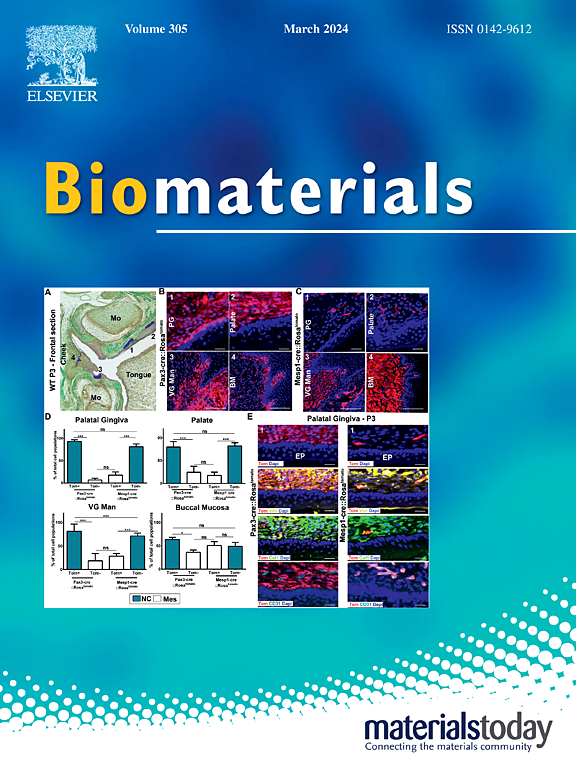Innovative sarcoma therapy using multifaceted nano-PROTAC-induced EZH2 degradation and immunity enhancement
IF 12.8
1区 医学
Q1 ENGINEERING, BIOMEDICAL
引用次数: 0
Abstract
Sarcomas are highly malignant tumors characterized by their heterogeneity and resistance to conventional therapies, which significantly limit treatment options. EZH2 is highly expressed in sarcomas, but targeting it is difficult. In this study, we uncovered the non-canonical transcriptional mechanisms of EZH2 in sarcoma and highlighted the essential role of EZH2 in regulating YAP1 through non-canonical transcriptional pathways in the progression of sarcoma. Building on this, we developed YM@VBM, a novel and versatile nano-PROTAC (proteolysis-targeting chimera), by integrating a polyphenol-vanadium oxide system with the EZH2 degrader YM281 PROTAC, encapsulated in methoxy polyethylene glycol-NH2 to enhance biocompatibility. To further facilitate targeted drug delivery to tumors, YM@VBM nano-PROTACs were incorporated into microneedle patches. Our engineered YM@VBM exhibited multiple functionalities, including the peroxidase-like activity to generate reactive oxygen species, depletion of glutathione, and photothermal effects, specifically targeting sarcoma characteristics. YM@VBM significantly enhanced targeting efficacy via inducing potent EZH2 degradation. Most importantly, it can also activate anti-tumor immunity via excluding myeloid-derived suppressor cells, maturing dendritic cells, and forming tertiary lymphoid structures. Hence, we reveal that YM@VBM presents a promising treatment strategy for sarcoma, offering a multifaceted approach to combat this challenging malignancy.
利用纳米多面protac诱导EZH2降解和免疫增强的创新肉瘤治疗
肉瘤是一种高度恶性肿瘤,其特点是异质性和对常规疗法的耐药性,这极大地限制了治疗选择。EZH2在肉瘤中高表达,但很难靶向。在本研究中,我们揭示了EZH2在肉瘤中的非规范转录机制,并强调了EZH2通过非规范转录途径调控YAP1在肉瘤进展中的重要作用。在此基础上,我们开发了YM@VBM,一种新型的多功能纳米PROTAC(蛋白水解靶向嵌合体),通过将多酚-氧化钒系统与EZH2降解剂YM281 PROTAC集成在甲氧基聚乙二醇- nh2中,以增强生物相容性。为了进一步促进靶向药物递送到肿瘤,YM@VBM纳米protacs被纳入微针贴片。我们设计的YM@VBM具有多种功能,包括产生活性氧的过氧化物酶样活性,谷胱甘肽的消耗以及光热效应,特别是针对肉瘤特征。YM@VBM通过诱导强效EZH2降解显著增强靶向效果。最重要的是,它还可以通过排除髓源性抑制细胞、成熟树突状细胞和形成三级淋巴结构来激活抗肿瘤免疫。因此,我们发现YM@VBM为肉瘤提供了一种有希望的治疗策略,提供了一种多方面的方法来对抗这种具有挑战性的恶性肿瘤。
本文章由计算机程序翻译,如有差异,请以英文原文为准。
求助全文
约1分钟内获得全文
求助全文
来源期刊

Biomaterials
工程技术-材料科学:生物材料
CiteScore
26.00
自引率
2.90%
发文量
565
审稿时长
46 days
期刊介绍:
Biomaterials is an international journal covering the science and clinical application of biomaterials. A biomaterial is now defined as a substance that has been engineered to take a form which, alone or as part of a complex system, is used to direct, by control of interactions with components of living systems, the course of any therapeutic or diagnostic procedure. It is the aim of the journal to provide a peer-reviewed forum for the publication of original papers and authoritative review and opinion papers dealing with the most important issues facing the use of biomaterials in clinical practice. The scope of the journal covers the wide range of physical, biological and chemical sciences that underpin the design of biomaterials and the clinical disciplines in which they are used. These sciences include polymer synthesis and characterization, drug and gene vector design, the biology of the host response, immunology and toxicology and self assembly at the nanoscale. Clinical applications include the therapies of medical technology and regenerative medicine in all clinical disciplines, and diagnostic systems that reply on innovative contrast and sensing agents. The journal is relevant to areas such as cancer diagnosis and therapy, implantable devices, drug delivery systems, gene vectors, bionanotechnology and tissue engineering.
 求助内容:
求助内容: 应助结果提醒方式:
应助结果提醒方式:


